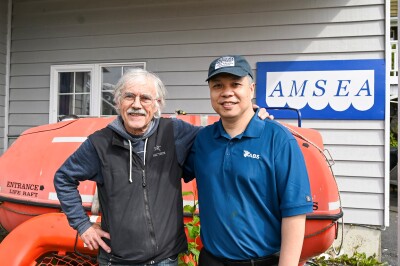U.S. mariners will fall under rules of the international Polar Code in just six weeks, culminating two decades of preparations to deal with increasing ship traffic and commercial activity in the high latitudes.
It means a new set of compliance and personnel requirements on ships operating beyond latitude 60° north or south – with some bends in the boundary line demanded by Norway, the U.S. and other seafaring nations.
For fishermen, warming waters and less ice in the far north raises the danger of invasive marine species, like the European green crab or manila clam riding in ballast water to colonize Alaskan habitats.
“With the increases of shipping and commerce, these areas become more and more vulnerable,” said Capt. John Faris, who commands the 120’ research vessel Tiglax that carries scientific teams to the Alaska National Maritime Wildlife Refuge.
The future of polar navigation was the subject of a speakers’ session during the first day of the annual Pacific Marine Expothat opened Thursday at the CenturyLink Field Event Center in Seattle.
The Polar Code, adopted in 2015 by the International Maritime Organization, imposed strict new requirements for new polar vessels built after Jan. 1, 2017.
More sets of rules – training requirements for masters, mates and watch officers, and operational rules for vessels – will go into effect Jan. 1, 2018, said Bob Parsons, a maritime ice navigation instructor and Arctic advisor with the Alaska state Department of Labor and Workforce Development.
In January 2016 the American Bureau of Shipping released its IMO Polar Code Advisory, a free, online handbook written in plain English to help mariners understand and comply with the code. The U.S. is a signatory to the agreement, so Coast Guard inspectors will be looking for operators to be in compliance, Parsons stressed.
Those interlinked requirements for ships operating in polar regions include operational assessments that calculate vessels’ abilities to operate in low temperatures and ice conditions, and the potential for abandonment at sea or on the coastline in an emergency. The International Association of Classification Societies has a standard for issuing polar ship certificates in A, B, and C categories – all less than the standards for U.S. icebreakers, Parsons noted.
With its mandates for safety of life at sea and pollution prevention, the Polar Code sets out rules for a rapidly changing sector of the world’s maritime economy – one where safety guidelines may, or may not, be followed.
One concern for national coast guards is the growth by commercial cruise lines of adventure cruise offerings off Antarctica and in U.S.-Canadian Arctic waters, far from search and rescue bases.
For most commercial vessels and fishing crews operating in those regions, survival exposure suits are by now a no-brainer requirement, Parsons noted.
As for cruise ships, “do you think they had Gumby suits for 4,000 people? No. But it was a good guideline,” he quipped.
By now, after decades of fisheries development and oil exploration in the far north, the dangers of operating there are well known: topside icing and instability, low temperature effects on mechanical systems and human performance, said Parsons.
Technological advancement is helping, like the extension of civilian satellite communications over the North Pole, where “previously once you were above 80 degrees north you couldn’t talk to anybody,” said Parsons, a retired Coast Guard officer and ice navigator.
Still there is much to be learned.
“Less than 10% of the Arctic is charted to those (modern) standards,” so there is not enough hydrographic data yet as more waters open to navigation, he noted. During a decade of duty in Antarctic waters, Parsons said, his best available charts could be old U.S. surveys from 1948, or even British and Chilean charts going back to the 1920s.
Then there is an issue of human expertise. When Royal Dutch Shell and other oil companies looked to explore in the U.S. Arctic, their search led to mariners experienced in earlier decades, but “most of those people were in their 70s and 80s,” said Parsons.
U.S. and Alaska wildlife biologists are counting on the experience of fishermen to help with an early warning system for biological invasions of a warming north, said Faris of the U.S. Fish and Wildlife Service. A veteran of 16 seasons aboard the Tiglax, Faris became captain in 2017 after serving as mate.
A first focus of the FWS was saving seabirds and marine mammal species around the Aleutians. The program scored success with eradicating imported foxes and rats from several islands, and re-establishing the Aleutian cackling goose on more than 30 islands.
“Usually the Endangered Species Act is a one-way ticket,” said Faris.
In the Alaskan coast sea, the Japanese skeletal shrimp and softshell clams are early invaders, with Atlantic salmon and American shad also seen but considered “strays,” for now, he said.
But Alaskan scientists have already developed a list ranking the most likely next invaders, including the green crab already in Washington’s Puget Sound.
Given climate trends, “we know they’re going to get there,” Faris told the audience. “You can be the eyes and ears on where we need to look … the main thing is we want your ideas.”







